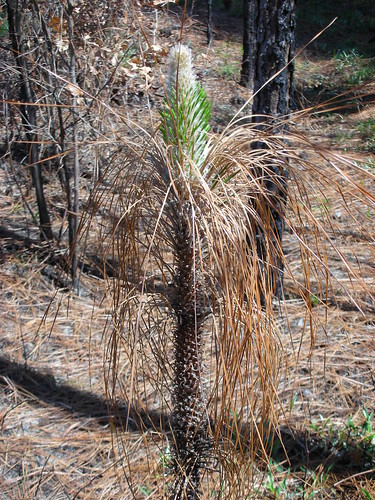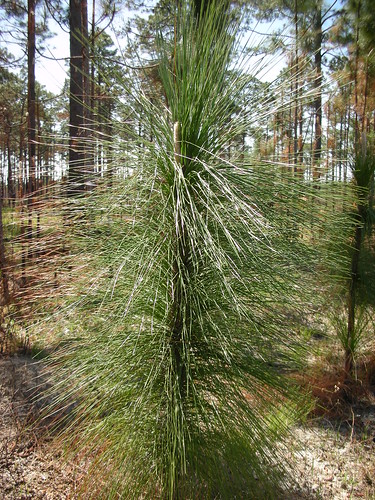 Instead of planting fast-growing slash or loblolly pines just to burn up in a biomass plant,
how about
plant the south’s iconic longleaf pine trees to capture and hold carbon from the atmosphere?
Instead of planting fast-growing slash or loblolly pines just to burn up in a biomass plant,
how about
plant the south’s iconic longleaf pine trees to capture and hold carbon from the atmosphere?
“Longleaf should be the centerpiece of land-based carbon sequestration efforts in the Southeast,” the report states, urging that national policymakers make the ecosystem as high a priority as the Everglades or Chesapeake Bay.The report is Restoring the Longleaf Pine: Preparing the Southeast for Global Warming, Published December 10, 2009 by the National Wildlife Federation and two southeast forest conservation groups, America’s Longleaf, and The Longleaf Alliance.
People rightly worry about deforestation in the Amazon basin of Brazil, but forget or never knew that we already did that right here in the southeast:
Longleaf pine has a storied history in the development of the South. As the dominant native pine of the region, its high-quality wood was used in both residential and commercial structures, including homes across the country and U.S. naval ships. Longleaf forests also provided a variety of other economic products including turpentine, pine straw, and recreational hunting habitat. Unfortunately, overcutting and replacement by short-rotation pine species or agricultural crops has greatly diminished the extent of longleaf pine. It once covered more than 90 million acres across eight states along the Atlantic and Gulf Coasts, but now is found on less than 3 percent of its historic range.
A longleaf pine forest is the most biologically diverse forest outside of a tropical rainforest. Many of its species are endemic, occuring nowhere else, such as the red-cockaded woodpecker, Bachman’s sparrow, and indigo snake. Others range more widely, but like longleaf: fox squirrel, gopher tortoise, and summer tanager. Plant species are even more numerous, such as wiregrass, pitcher plants, six kinds of blueberries, three of huckleberries, and gallberries. Most people have no idea of what grows in the remaining patches of these woods.
This trend of deforestation didn’t stop with cutting down almost all the original forest cover of Georgia: then we started paving it over. Just before the recent economic recession Atlanta was paving 55 acres a day.
We can undo this environmental devastation and in so doing help save ourselves from its ongoing effects:
Longleaf pines can grow in both very dry and very wet conditions, according to the report. They weather severe storms and thrive with fire. This also makes them less susceptible to Southern pine beetles.Less flooding, less erosion, and more game animals (bobwhite, turkey, deer). All that plus mitigation of pollution, both CO2 and other pollutants. And it’s still possible to selectively log a maturing longleaf forest: just don’t cut them all down; only a small fraction per year. Meanwhile the bigger trees keep getting bigger. Longleaf top out somewhere near 120 feet tall, but they can live for 500 years.The report cites a study of tree death and damage after Hurricane Katrina, when slash and loblolly pines were more likely to snap or die than longleaf pines. It also notes that areas planted with longleaf were mostly undamaged by South Carolina wildfires that devastated the Myrtle Beach area earlier this year.
Because longleaf pines live much longer than other Southern pine species, they end up with a much denser wood that stores more carbon. Even after death, longleaf trees release their carbon more slowly.
 Sure, none of us will live that long, but right now there’s little
market for pulpwood, and biomass plants emit CO2 and particulates.
So there’s an immediate economic benefit to planting longleaf,
for example through the Conservation Reserve Program managed by the Georgia
Farm Service Agency.
There is stimulus money to do even more of that. Plus:
Sure, none of us will live that long, but right now there’s little
market for pulpwood, and biomass plants emit CO2 and particulates.
So there’s an immediate economic benefit to planting longleaf,
for example through the Conservation Reserve Program managed by the Georgia
Farm Service Agency.
There is stimulus money to do even more of that. Plus:
Love said the outcome of federal climate change legislation and carbon markets could change the way trees are grown in the Southeast. Currently, the California carbon market encourages forests where the trees are not all the same age, species are diverse and logging occurs less often. If that standard became the national one, many pine plantations in the Southeast wouldn’t be eligible to enroll.Which would mean that pines in the southeast would start being managed more naturally, rather than through the current even-age tree factory system. That would help prevent the kind of massive wildfires such as happened around the Okefenokee in 2007.
Love noted that credits on the California carbon market sell for twice as much as those from other registries.It’s not like we don’t know how to manage uneven-aged longleaf forests. The Wade Tract near Thomasville has long demonstrated how to do it, and that you can make a profit on a long-lived uneven-aged longleaf forest by selling saw-timber from it from time to time. If you can also sell shares into a carbon market like the one in California, forest owners stand to profit, and the whole region stands to benefit from stands of longleaf pine trees.“If the economics reach a point where it makes more sense to manage for carbon than poles on pulp, … that might actually give an incentive for people to do things like longer rotations and different species,” he said.
Mitchell said the Jones Center is working with people who developed the California carbon rules to study how a longleaf forest owner might fare in that carbon market structure.
Short Link: